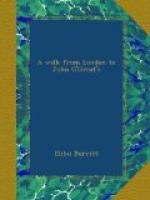never sold any, and was not in the habit of noticing
the market quotations of those products. I was
surprised at one fact which I learned in connection
with his economy. He keeps about 170 bullocks;
buying in October and selling in May. Now, it
would occasion an American farmer some wonderment
to be told that this great herd of cattle is fed and
fatted almost entirely for the manure they make.
It is doubtful if the difference between the cost
and selling prices averages 2 pounds, or $10, per
head. For instance, the bullocks bought in will
average 13 or 14 pounds. A ton of linseed-cake
and some meal are given to each beast before it is
sent to market, costing from 10 to 12 pounds.
When sold, the bullocks average 24 or 25 pounds.
Thus the cake and the meal equal the whole difference
between the buying and selling price, so that all
the roots, chaff, and attendance go entirely to the
account of manure. These three items, together
with the value of pasturage for the months the cattle
may lie in the fields, from October to May inclusive,
could hardly amount to less than 5 pounds per beast,
which, for 170, would be 850 pounds. Then 1,700
pounds are paid annually for guano and artificial manures.
Now add the value of the wheat, oat and barley straw
grown on 1,500 acres, and mostly thrown into the barn-yards,
or used as bedding for the stables, and you have one
great division of the fertilising department of Chrishall
Grange. The amount of these three items cannot
be less than 3,000 pounds. Then there is another
source of fertilisation nearly as productive and valuable.
Upwards of 3,000 sheep are kept on the estate, of
which 1,200 are breeding ewes. These are folded,
acre by acre, on turnips, cole, or trefoil, and those
fattened for the market are fed with oil-cake in the
field. The locusts of Egypt could not have left
the earth barer of verdure than these sheep do the
successive patches of roots in which they are penned
for twenty-four or forty-eight hours, nor could any
other process fertilise the land more thoroughly and
cheaply. Then 76 horses and 200 fattening hogs
add their contingent to the manurial expenditure and
production of the establishment. Thus the fertilising
material applied to the estate cannot amount to less
than 5,000 pounds, or $24,000, per annum.
Sheep are the most facile and fertile source of nett income on the estate. Indeed, nearly all the profit on the production of meat is realised from them. Most of those I saw were Southdowns and Hampshires, pure or crossed, with here and there a Leicester. After being well fattened, they fetch in the market about double the price paid for them as stock sheep. About 2,000, thus fattened, including lambs, are sold yearly. They probably average about 2 pounds, or $10, per head; thus amounting to the nice little sum of 4,000 pounds a year, as one of the sources of income.




